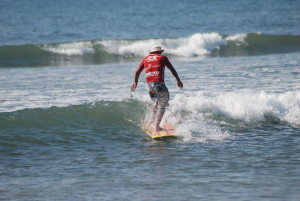By: Barbara and Gunnar Erickson
The Ocean Waves!
As soon as we arrive at the coast, we head to the beach and enjoy the waves. The tropical water is always warm and the beaches call out for walks and beachcombing. Standing at the tide line, feeling the salty spray on your skin and face, and sensing the power of the waves, we mused about the forces of nature that bring waves and shape our coasts. And with the help of the Internet, we’ve learned some things about them.
Ocean Waves Move Energy
Ocean waves, like all waves (sound, electric, radio…) move energy. For the most part, ocean waves are generated by wind in the open sea. Wind moves from cooler dense areas (high pressure) to warmer less dense areas (low pressure). Bursts of moving air press down on the surface of the sea, transferring some of the wind energy to the water and forming the wave. As the wind pushes the water, the waves begin to travel and take on some uniformity building into swells.
Curiously and counter-intuitively, waves in the open ocean are not moving large bodies of water forward; the water only reacts to energy spiraling through it. As the energy wave passes, the water column below the wave orbits in place, bulging at the top and dipping in the trough. It is something like a log rolling down a hill. The energy in the wave is measured by the wavelength and height, the higher the wave crest, the deeper the orbit of the water column. It is only when the wave approaches the coastline and shallow water that things get interesting.
The wave’s length gets shorter as the wave’s orbit begins to drag along the seafloor. The resulting friction causes the waves to slow at the bottom of the orbit and build up at the top until the crest of the wave is too far forward and no longer supported by the orbiting column of water below. Then it tips forward and up at the top until the waves finally break over themselves in a swash of released energy. This breaking of the wave takes place when its depth from the sand is about 1.4 times the height of the wave. So a five-foot-high crest breaks in about seven feet of water.
Waves Shape Our Coastlines and Beaches
The energy of waves continuously shapes our coastlines and beaches. Waves disperse their energy by striking first on headlands and then dispersing it in the bays. They are powerful agents of erosion, cutting away at the headlands and depositing the sediments in bays. Waves can move massive amounts of sand and sediments in a very short period, as anyone who has witnessed a summer storm can tell you. Over time, beaches may come and go all due to the power released by waves.
There are days when the swells are so tall that you can see them coming far out to sea. We think about where they are coming from and how windy it must have been there. On other days, the waves are small and lap at the toes of children jumping them in the sand. There is no wind at sea today. We can enjoy the soft release of wave energy, so different than the pounding surf of the day before.


